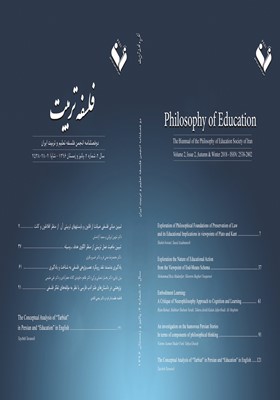تبیین ماهیت عمل تربیتی از منظر الگوی هدف ـ وسیله
محورهای موضوعی :محمد رضا مدنی فر 1 , خسرو باقری 2
1 - 0
2 - دانشگاه تهران
کلید واژه: عمل تربیتی, الگوی هدف ـ وسیله, رویکرد اسلامی عمل,
چکیده مقاله :
قرار دادن عمل تربیتی ذیل الگوی هدف ـ وسیله، امری مورد بحث و مناقشهآمیز است. مخالفتها با پذیرش این الگو متکی بر دلایل متفاوتی است که از جمله میتوان به تعارض آن با عاملیت متربی یا نادیده انگاشتن وجه اخلاقی در تربیت اشاره کرد. در مقابل، مستثنا کردن عمل تربیتی از این الگو نیز بهنوبه خود با مشکلات و چالش هایی مواجه است. این مقاله در راستای انتخاب موضعی مناسب در این بین، ابتدا بر اساس مفهوم اسلامی عمل، تفکیک ارسطویی عمل به دو نوع عمل ابداعی و عمل اقدامی را مورد نقد قرار میدهد. بر مبنای این نقد، دوگانگی مورد اشاره از عمل نزد ارسطو نفی شده و شکل موسّعی از الگوی هدف- وسیله که همه اعمال آدمی را شامل میشود، معرفی میگردد. بر همین مبنا، عمل تربیتی ابتدا به شکل یک تعامل یعنی ترکیبی از دو عمل تربیت نمودن و تربیت یافتن که به ترتیب از سوی مربی و متربی محقق میشود، تبیین گشته و نسبت هر یک از این اعمال با الگوی پیشنهادی تحلیل میگردد. در نهایت نشان داده میشود که الگوی پیشنهادی چگونه میتواند از ضعف ها و نواقصی که در دو تبیین سنتی از ماهیت عمل وجود دارد مصون بماند.
Subordination of educational action to End-Means schema is controversial in philosophy of education. Disagreements on this schema are due to different reasons, such as the conflict between this schema with student autonomy and the undermining of moral aspects of education in this model. On the other hand, the exclusion of educational action from the End-Means schema raises, in turn, some challenges. In order to take an appropriate position on this matter, this paper criticizes the Aristotelian distinction between praxis and poises based on the Islamic conception of action. Based on this critique, an extended version of End-Means schema is introduced for all human actions. Then, the educational action is first explained in terms of an interaction, namely a combination of two actions of educating and being educated issued by the educator and the pupil respectively and each of these actions is analyzed in relation of the suggested schema. In the end, it is shown that how the suggested schema is free from the weaknesses and defects of the traditional explanation of action.
